As Diogenes went off with his lantern to look for an honest man, at Elie Wine Company, we take special pride in illuminating lesser known French and Spanish wine regions and spotlighting passionate winemakers who often fly beneath the global radar. As a result, their wines tend to be priced far below their actual worth. They are honest wines with interesting backstories, fascinating personal histories and the likelihood of bright futures.
Diogenes never found his man, but this week’s selection is just a small sample of what our lantern has uncovered.
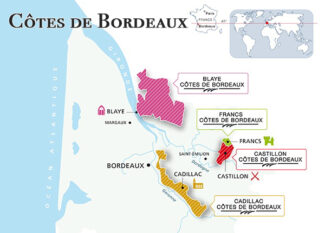
| The creation of the Côtes de Bordeaux appellation in 2009 was an attempt to unite four lesser-known wine producing areas (Premieres Côtes de Blaye, Côtes de Castillon, Côtes de Francs, and the red wines from the Cadillac district) under a single commercial network. The move has had mixed results, primarily because the identities of each were already well-established locally and these regions are not necessarily near one another. Francs and Castillon are located at the eastern end of the Bordeaux region, while Blaye is in the northwest and Cadillac in the south.
The banner of each remains distinct, therefore, and the qualities of their individual terroirs are not amenable to a generic appellation name. That can only be determined by a judicious examination of their wines. This week, our focus is on Castillon. |
|
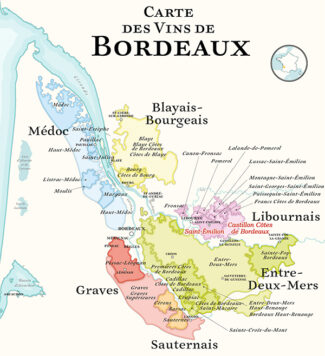
Castillon – Côtes de Bordeaux
|
|
| Castillion is Merlot country; the district, at the very eastern edge of Bordeaux between Libourne and Bergerac (abutting Saint-Émilion) contains multiple clay-rich sites in the foothills of the limestone plateau on which the town Saint-Émilion is located. With over 7000 acres under vine (70% of which is Merlot) the appellation produces only red wine, and nearly all blends with the satellite variety Cabernet Franc, which accounts for 28% of the harvest, and Cabernet Sauvignon, making up a scant 2%.
Geologically, much of the area is an extension of the limestone ridge that runs through Saint-Émilion’s greatest estates, while some sites boast the soil structures of Pomerol. Since the price of land in Castillon remains reasonable, many of the top estates from these storied Bordeaux regions have bought land here and raised the overall quality of the wine. As an example, vineland in Castillon sells for around $10,000 per acre, while in the Grand Cru climats of Saint-Émilion, that same amount of space easily exceeds a million dollars. In total, 230 vignerons and vigneronnes work Castillon terroir.
The area drips with as much history as juice; the Battle of Castillon, which took place on 17 July 1453, marked not only a decisive French victory over England, it signaled the end of the Hundred Years’ War. |
|
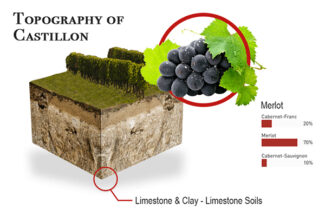
Merlot – Castillon’s Primary Grape
|
|
| Merlot’s bad rap has been largely exaggerated; it is a wine with so much upside that the naysayers may simply be jealous. A chameleon of styles, the name translates to ‘little blackbird’, and indeed, as a stand-alone variety, it produces wines that are as soft, supple and sensuous as a bird’s feather. But in France, it generally takes on its most important role as a co-star, especially when paired with Cabernet Sauvignon. Merlot is less tannic and less acidic than Cabernet Sauvignon, and its velvety texture rounds out Cab’s edges. Plus, as a variety that matures earlier, the proportion of Merlot in a blend can shorten the time a Bordeaux needs to be cellared.
Although Cabernet Sauvignon remains the premier grape throughout Bordeaux, some of the sub-regions, especially with damp, poorly drained soils and high clay content, are far more suited to Merlot than the dry-root-loving Cabernet. The area to the north of the Dordogne river, which feeds into the Gironde estuary and eventually meets the Atlantic Ocean, is particularly suited to Merlot. Proof is in the producer; the most famous appellations producing Merlot-centered wines are Pomerol and St-Émilion. |
|
| This 10-Bottle Pack at $338 contains two of each of the following six wines: |
|
2019 Vintage: Elegant & Harmonious
|
|
| Following a mild, early spring (and associated early bud break), the summer of 2019 was among the hottest on record. On the Left Bank, especially on estates with quick-draining soils, some vines shut down completely. Right Bank wines with vines on thicker clay soils tended to retain more water and ultimately performed better, while the sizzling heat of summer ensured that grapes were rich in sugar. The very end of July saw some heavy rains.
2019 Right Bank wines are intensely concentrated, and the Merlot harvest wound up being particularly generous and intense. |
|
| “Tempo d’Angélus was created as an alternative direction; a transposition of everything that makes up the Angélus world of excellence onto an approachable level,” says Stéphanie de Boüard-Rivoal. Translated, this means, “This is an affordable version of our flagship wine.”
Demystifying the Angélus name (Premier Grand Cru Classé in the Classification of Saint-Émilion, 2012) was the goal of 40-year-old de Boüard-Rivoal, who has headed Château Angélus for the past decade. To accomplish this, she oversaw the purchase of a number of plots in Castillon-la-Bataille and Sainte-Colombe, a few miles to the east of their illustrious estate in Saint-Émilion. The wine is intended to be a streamlined version of Château Angélus, Carillon d’Angélus and N°3 d’Angélus, offering the same depth and complexity while being more approachable young—a trick achieved, in part, by using a greater proportion of Merlot. |
|
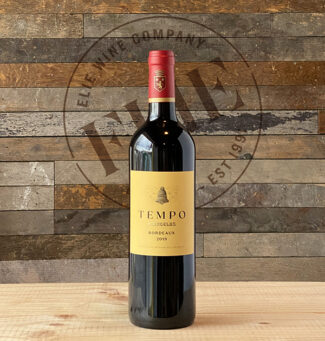 Tempo d’Angélus 2019, Bordeaux ($31)
Tempo d’Angélus 2019, Bordeaux ($31)
The 2019 Tempo d’Angélus is composed of 90% Merlot and 10% Cabernet Franc, and is an exuberant wine from every perspective. Deep garnet-purple in color, offers it blackcurrant jam on the nose, and is filled with perfumed spice notes of sandalwood and cedar with rich chocolate and smoky minerality.
2018 Vintage: Powerful & Exuberant
|
|
| Retrospective opinions of 2018 in Bordeaux range from excellent to legendary; superlatives are only tempered by the fact that global warming may account for the ‘new’ climate in this part of France, which are characterized by hot, dry summers with intermittent bouts of violent thunderstorms that often decimate vines. In any case, the fruit that remains tends to be small, thick-skinned and highly concentrated, and if less wine is produced, it can be extremely intense.
The 2018 harvest was accompanied by particularly pleasant weather, with a string of dry days and cool nights being key to the overall success. |
|
| L’Hêtre, formerly Château Goubau and neighboring property Château Montagne, sits on a varied and rich biotope on the Saint Philippe d’Aiguilhe plateau, the highest point in Bordeaux. Jacques Thienpont, proprietor of the tiny (6 acres) Château Le Pin, visited the properties in 2015 and fell in love with the southeasterly exposures, the continuous gentle breeze and the terroirs, divided between the limestone plateau and a mixture of clay, limestone and chalk soil slopes. With his sister Anne De Raeymaeker, Jacques decided to purchase the estate as an investment for the two branches of the Thienpont family; they hired their nephew Maxime Thienpont, who had grown up at another family estate Château Labégorce Zédé in Margaux, to manage the estate. They renamed the property ‘L’Hêtre’, a species of French beech, thus continuing the arboreal theme that Jacques uses for all his estates.
Upon taking the reins, the Thienponts aged the 2015 wines according to their own specifications. The 2016 vintage was the first one made entirely by the new owners and is therefore the first to carry the name L’Hêtre. The striking artwork for the labels was created by Belgian artist Anne Van Hereweghen. |
|
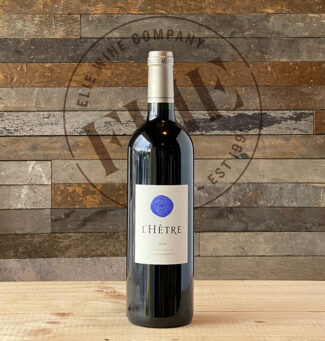 L’Hêtre 2018, Castillon – Côtes de Bordeaux ($34)
L’Hêtre 2018, Castillon – Côtes de Bordeaux ($34)
L’Hêtre’s third vintage, with harvest completed on 11 October, is 95% Merlot and 5% Cabernet Franc, and shows a rich depth of Damson plum, cherry compote, licorice and kirsch; the tension is lively and the tannins are finely-grained crushed velvet.
| Located in the town of Monbadon along the right bank of the Dordogne, Château Jouanin began as a hobby-project for the current director’s father. Having moved to Bordeaux from Béziers in Languedoc, the 26-acre estate was purchased primarily as a residence for the Taix family, which also owns the 30-acre Château Fongaban in Puisseguin-Saint-Émilion. The elder Taix was a machinist; his son Georges and grandson Pierre now run the estate.
Vinification techniques are typical for the region; machine-picking is preferred, and the wines undergo primary fermentation in stainless steel or concrete vats before being transferred to French oak barrels of various ages, then are bottled after 15 months. |
|
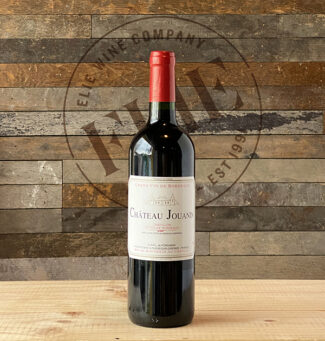 Château Jouanin 2018, Castillon – Côtes de Bordeaux ($13)
Château Jouanin 2018, Castillon – Côtes de Bordeaux ($13)
90% Merlot and 10% Cabernet Franc, the wine is seductive and powerful with fleshy fruit in the foreground and a bouquet of cassis, eucalyptus on the nose and a kick of spice. The lushness of the blackberry gives the wine a wonderful opulence and provides a cushion that allows the wine’s acidity and tannins to balance.
2016 Vintage: Supple & Juicy
|
|
| Despite tenuous beginnings, 2016 wrapped up to be a phenomenal vintage in Bordeaux. The preceding winter was unseasonably warm and temperatures remained high throughout the wet spring; this forestalled the hailstorms that frequently plague the region near budburst. The summer that followed was hot and dry, allowing waterlogged roots to re-establish themselves. In general, the harvest was slightly larger than typical in Bordeaux and of exceptionally high quality; the red wines are considered to be among the best on record.
Right Bank wines are especially noteworthy in 2016, combining purity with elegance and an enduring freshness that persists through generally rich tannins. |
|
| Although Montlandrie was founded in the nineteenth century by an Italian family, it is perhaps emblematic of the sort of properties that have come increasingly to represent Castillon. Purchased in 2009 by the late Pomerol’s Denis Durantou, who recognized that the single-block 30 acre vineyard possessed a terroir identical to Saint-Émilion’s top estates; the soil structure is clay limestone and the elevation, at around 250 feet, mirrors that of some Grand Cru vineyards. |
|
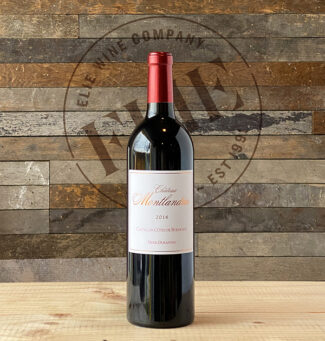 Château Montlandrie 2016, Castillon – Côtes de Bordeaux ($33)
Château Montlandrie 2016, Castillon – Côtes de Bordeaux ($33)
2016 was the first vintage that Montlandrie fully barrel-aged their wine, using 40% new oak. As in previous vintages, though, it is vinified in 15 small, temperature-controlled stainless vats (one per vineyard parcel) ranging in size from 24 hectoliters to 82 hectoliters; malolactic fermentation takes place in these vats.
Montlandrie’s vineyards are 65% Merlot and 20% Cabernet Franc and 15% Cabernet Sauvignon, and the cuvées are similar; 2016 has all the hallmarks of the spectacular vintage, medium-bodied and chewy with spicy plum framed by earthy smoke and cinnamon notes.
| The hamlet of Joanin is merely a blink; a row of roadside residential properties in the commune of St-Philippe-d’Aiguilhe. But it has a long history of viticulture due in the main to Château d’Aiguilhe, sitting less than a mile to the south. There is also a lieu-dit called Joanin, and this is the 30 acre vineyard that makes up the estate. At a thousand feet above sea level, this is the highest land along the Gironde, and Juliette Bécot, owner and vigneronne, treats her vines like prize-winning rose bushes, thinking of her Castillon vineyard as a beautiful and refined garden. Also the head of Château Beau-Séjour Bécot in Saint-Émilion, Bécot’s goal is ‘to breathe new life into Bordeaux, crafting elegant, accessible and terroir-driven style wines.’
The vineyard is planted to 75% Merlot and 25% Cabernet Franc; the vines have an average age of 35 years. |
|
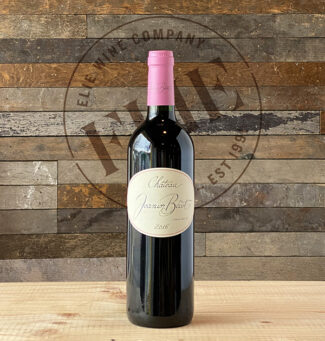 Château Joanin Bécot 2016, Castillon – Côtes de Bordeaux ($36)
Château Joanin Bécot 2016, Castillon – Côtes de Bordeaux ($36)
An opulent champion for the limestone soils of the Côtes de Castillon, the wine is 80% Merlot and 20% Cabernet Franc, aged on the lees in 65% new and 35% year-old oak for 15 months. The result is an open-knit scents of exotic spices—star anise, fenugreek and cumin—over a core of plum preserves, baked cherries and blueberry compote with touches of dark chocolate and chalky minerality.
| The château is something from a fairy tale, with turrets, vaulted ceilings and a convoluted history; engraved on one of the stone building blocks is ‘On 8 August 1626, here I built this home’ —Pitray also rents rooms if you’re interested. The vineyards span 150 acres and the vines are middle-aged at around 35. Winemaker Jean de Boigne, in whose family the estate has been since before Columbus tripped over the Bahamas, says, “Castillon remains an unknown wine region. We are between six and nine kilometers east of Saint-Émilion, with exactly the same soil. At the bottom of the appellation, close to the river, close to the town of Castillon, you have clay and sandy soil, which makes very fruity wines. And on the upper part of Castillon, where Château Pitray is, you have more limestone and clay, and that brings minerality and makes a more complex wine.”
De Boigne champions Cabernet Franc, and it shows in his wines. He claims, “Merlot? Everybody makes Merlot. Here at Pitray, we grow 75% Merlot, 23% Cabernet Franc, and 2% Malbec, and I’m always pushing to plant more Cabernet Franc. With the soil we have here, I think it makes a more interesting wine.” |
|
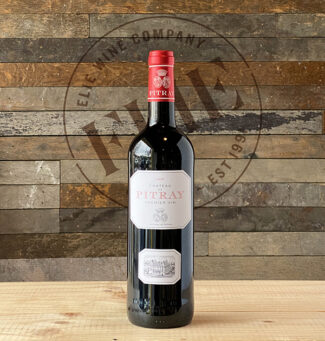 Château de Pitray 2016, Castillon – Côtes de Bordeaux ($22)
Château de Pitray 2016, Castillon – Côtes de Bordeaux ($22)
75% Merlot, 23% Cabernet Franc, 3% Malbec: The Cabernet Franc is assertive here, with slight green pepper notes rounding out the blackberry pie brought by the Merlot. Additional flavors of mulberry and hints of spice cake, aniseed and tobacco. There is a lovely freshness and an approachable, soft texture that frames the fruit, finishing long and savory. 6000 cases produced.
Add one bottle of the following wine for a baker’s dozen at $380.
| Stephan von Neipperg (owner of six châteaux in and around Saint-Émilion, including d’Aiguilhe) has a sense of humor that precedes him: Of the cellar-full of La Gaffelière made before he took over he says, “Oh, they’re so good, I give them away to the gendarmes each time I get a speeding ticket.”
His superpower has been in taking under-producing properties and turning them into blockbusters; the consequence of his passion and his euros. He starts by modernizing the wineries, but in his customary dress (boldly striped ascots and silk handkerchiefs tucked into double-breasted blazers) he hardly looks like a revolutionary. At Château D’Aiguilhe he invested a small fortune in upgrades, including a gravity-based system that he believes, along with the Castillon terroir, is capable of producing masterpieces. He insists that D’Aiguilhe is his favorite property: “Castillon seems basic and elemental in ways that the Saint-Emilion does not. Everything I have ever learned about wine, I have brought here.” |
|
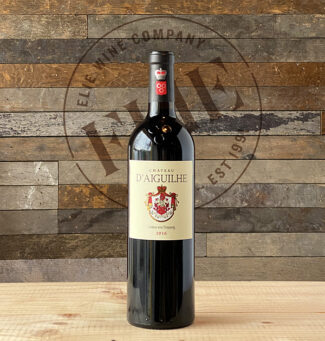 Château D’Aiguilhe 2016, Castillon – Côtes de Bordeaux ($42)
Château D’Aiguilhe 2016, Castillon – Côtes de Bordeaux ($42)
A core of blueberry, blackberry and ripe Morello cherry is laced with mocha and oak spice. 80% Merlot and 20% Cabernet Franc, the wine is persistent on the palate with whiffs of underbrush and menthol.
- - -
Posted on 2022.02.18 in France, Bordeaux, Wine-Aid Packages



 Tempo d’Angélus 2019, Bordeaux ($31)
Tempo d’Angélus 2019, Bordeaux ($31) L’Hêtre 2018, Castillon – Côtes de Bordeaux ($34)
L’Hêtre 2018, Castillon – Côtes de Bordeaux ($34) Château Jouanin 2018, Castillon – Côtes de Bordeaux ($13)
Château Jouanin 2018, Castillon – Côtes de Bordeaux ($13) Château Montlandrie 2016, Castillon – Côtes de Bordeaux ($33)
Château Montlandrie 2016, Castillon – Côtes de Bordeaux ($33) Château Joanin Bécot 2016, Castillon – Côtes de Bordeaux ($36)
Château Joanin Bécot 2016, Castillon – Côtes de Bordeaux ($36) Château de Pitray 2016, Castillon – Côtes de Bordeaux ($22)
Château de Pitray 2016, Castillon – Côtes de Bordeaux ($22) Château D’Aiguilhe 2016, Castillon – Côtes de Bordeaux ($42)
Château D’Aiguilhe 2016, Castillon – Côtes de Bordeaux ($42)


